Introduction
In recent years, cryptocurrencies have emerged as a transformative force in the financial landscape, challenging traditional payment systems. This shift has prompted governments and banks worldwide to reassess their views on the use of crypto for payments. As digital currencies continue to gain traction, it is crucial to understand how these institutions perceive and respond to this innovation.
Government Perspectives on Crypto for Payments
Governments around the world have varied responses to the rise of cryptocurrencies as a payment method. Some view it as a potential tool for financial inclusion, providing access to financial services for the unbanked population. Others, however, raise concerns about security, money laundering, and the evasion of capital controls.
Regulatory Approaches
Regulations differ significantly across countries. While some countries, such as El Salvador, have embraced cryptocurrencies by making Bitcoin legal tender, others have taken a more cautious route. For instance, countries like India and China have imposed strict regulations to control the use of cryptocurrencies. The regulatory landscape is complex and constantly changing, requiring ongoing adaptation by both governments and users of digital currencies.
Each country’s regulatory attitude is influenced by its economic environment, existing financial infrastructure, and policy objectives. Countries with high inflation or unstable national currencies might see cryptocurrencies as an opportunity, while those with more stable economies tend to be careful in their approach.
Concerns over Financial Stability
Many governments express concerns about the potential impact of widespread crypto adoption on financial stability. The decentralized nature of cryptocurrencies poses a challenge to traditional regulatory frameworks, as it can potentially undermine monetary policies and disrupt existing financial systems. For instance, the volatility of digital currencies might lead to rapid fluctuations that can impact savings and economic plans.
Furthermore, there is apprehension about the possibilities of leveraging cryptocurrencies for illicit activities, such as financing terrorism and conducting illegal trade. Thus, collaborative international efforts are needed to create resilient legal frameworks that address these challenges.
Banking Sector’s Approach to Crypto Payments
Banks generally exhibit a cautious attitude towards cryptocurrencies, given the risks and uncertainties associated with them. However, the banking sector’s response is gradually evolving as institutions explore ways to integrate digital currencies into their operations.
Adoption and Integration
While some banks remain resistant, others are more open to exploring the potential of blockchain technology and cryptocurrencies. A growing number of banks are collaborating with fintech companies to offer crypto-related services, such as digital wallets and cross-border transactions. This movement is indicative of the increasing pressure on traditional financial institutions to innovate and stay competitive in a rapidly evolving market.
Blockchain technology itself offers numerous potential efficiencies, such as faster settlement times and reduced transaction costs, that banks find attractive. There is also interest in exploring central bank digital currencies (CBDCs) as a means to harness the benefits of digital currencies while retaining government oversight and control.
Risk Management and Compliance
Banks are increasingly focusing on developing robust risk management frameworks to mitigate the risks associated with cryptocurrencies. Compliance with anti-money laundering (AML) and know your customer (KYC) regulations remains a priority to ensure secure and transparent transactions. These frameworks help prevent the misuse of digital currencies while fostering an environment of trust among users.
As part of these efforts, banks are employing advanced analytics and technologies to monitor suspicious activities and enforce regulatory compliance. Partnerships with technology firms have also emerged as a strategy to address the complexities involved in the digital currency ecosystem effectively.
Conclusion
The views of governments and banks regarding the use of cryptocurrencies for payments are diverse and continue to evolve. There is potential for crypto to revolutionize payment systems, but the associated risks cannot be overlooked. The future of cryptographic money remains a blend of opportunity and uncertainty, with regulatory frameworks and technological advancements playing a pivotal role in shaping its trajectory.
As the crypto landscape matures, it is anticipated that regulatory clarity and technological innovations will shape the future of digital payments. Governments and financial institutions must strive to balance innovation with caution, ensuring that the positive attributes of cryptocurrencies can be harnessed while minimizing their risks.
In this evolving scenario, fostering international cooperation and dialogue will be crucial. A shared understanding of the potential implications of cryptocurrencies can pave the way for a cohesive approach to governance and utilization. As these technologies continue to unfold, they may redefine the traditional notions of currency and transaction methods, ultimately leading to a more inclusive global economic environment.
This article was last updated on: August 21, 2025







